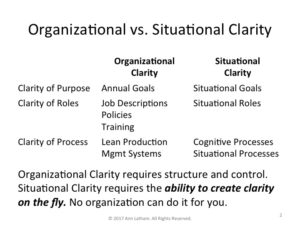 Most well-run organizations are pretty good at creating what I call “Organizational Clarity.” They have strategic priorities and annual goals. They have job descriptions, policies, rules, and training programs. They have well-defined and documented production processes. They also have well-defined management systems that control things like performance reviews, budgeting, approval processes, and projects. All told, these constitute a yeoman’s effort to create:
Most well-run organizations are pretty good at creating what I call “Organizational Clarity.” They have strategic priorities and annual goals. They have job descriptions, policies, rules, and training programs. They have well-defined and documented production processes. They also have well-defined management systems that control things like performance reviews, budgeting, approval processes, and projects. All told, these constitute a yeoman’s effort to create:
- Clear purpose,
- Clear roles, and
- Clear process
– the three keys to productive, effective, committed employees. The resulting structure and controls are essential for allowing growing and shifting numbers of people to work together effectively.
But there’s a problem with this: It doesn’t help employees get through their average workday.
Why Employees Still Lack Clarity of Purpose
Those annual goals, even if individualized and broken down by quarter, don’t help people establish goals for the next hour, the next conversation, the next email, or the next meeting. Those annual goals don’t help people figure out what to do when their priority list has gotten so long that they have no priorities. Those annual goals don’t help much when priorities shift or projects fail. No, these top-down efforts to create organizational clarity simply do not create the clarity of purpose employees need to be efficient and effective on a daily, hourly, and quarter-hourly basis. It isn’t possible.
Why Employees Still Lack Clarity of Roles
Those job descriptions and employee handbooks don’t create sufficient clarity of roles either. Job descriptions have limited value when you are in the trenches. Actual roles vary with each request, each relationship, and availability. While you might be willing to leave the details of a project to Dean because he’s a detail guy, you know you would be crazy to ask the same of Paul, who is never to be trusted with methodical, detailed tasks. And when Sarah is suddenly shipped off to troubleshoot a problem at a customer site, you have no choice but to fill the gap yourself or find a substitute. No, these efforts to predefine roles may make management feel like everything is under control, but they can’t possibly create the clarity of roles employees need to deal with daily reality.
Why Employees Still Lack Clarity of Process
The same can be said about clarity of process. Clear processes create efficiencies. But efforts to establish Organizational Clarity control only two types of processes: production processes and management system processes. Those processes don’t help employees get through meetings or make decisions. They don’t help employees solve messy problems. As a matter of fact, unless your work is closely tied to the assembly line, you probably benefit from about zero processes that make your work predictable and repeatable. No Organizational Clarity does not create the kind of clarity of process that makes for efficient, highly productive employees.
And it can’t! Top-down controls leave huge gaps.

What employees need, for up to 90% of the day, is the ability to create Situational Clarity. Clarity on the fly! They need to be able to create Situational Goals, Situational Roles, and Situational Processes. And they need to be able to create these on their own, when they need them. No organization can do it for them!
And yet, when organizations want to improve results, where do they focus their attention?
- They make new goals
- They tighten up job descriptions
- They write new policies
- They lay on the training
- They create new management systems
In other words, they do everything they can to pump up the top down Organizational Clarity. They do nothing to improve the organization’s ability to create Situational Clarity on the Fly!
If you want to make significant gains in productivity, engagement, and profits, your employees need to improved their ability to create clarity on the fly! No one can do it for them.
| Organizational Clarity | Situational Clarity |
| System-wide | Circumstantial |
| Top-down | Decentralized |
| Driven by annual goals | Requires minute by minute goals |
| Establishes rules | Depends on cognitive tools |
| Stable and slow to change | Agile, flexible, and fast |
| Anticipated and prescribed | Spontaneous and immediate |
| Hierarchical | Levels the playing field |
| Constraining | Empowering! |
Want to join my corporate clients who see the ability to create Situational Clarity on the Fly! as a tremendous opportunity to increase productivity and establish a surprising competitive edge? Get in touch right away! 603-784-5727.


[…] is time to focus on clarity and acquire the skills that will allow you and your employees to create clarity on the fly. Creating a culture of clarity requires investing in a paradigm shift and new skills, but the […]